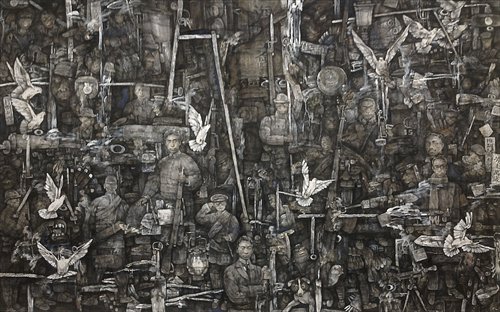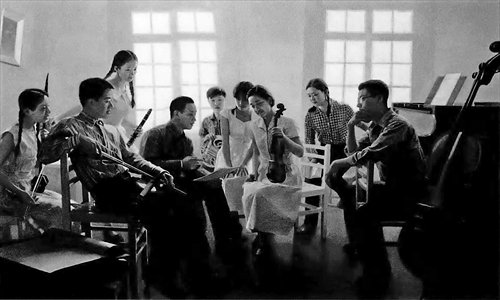History on canvas
A painting named The Butterfly Lovers features neither butterflies nor lovers, but instead a group of musicians sitting around with their instruments in discussion.
This painting commemorates the birth of a famous violin concerto in Shanghai in 1958, The Butterfly Lovers. The concerto was based on a classical Yueju Opera, which told a tragic love story about a pair of lovers, Liang Shanbo and Zhu Yingtai, who transform into a pair of butterflies.
The painting is on display as part of a new exhibition at the China Art Museum, Shanghai, entitled Chinese Classical Painting in the Past Century - Art Creation Project Based on History and Culture of Shanghai. The exhibition is made up of around 200 pieces that include oil paintings, engravings, traditional Chinese ink paintings and sculptures.

Third Workers' Armed Uprising in Shanghai
Most of the pieces were commissioned to remember important historical events in Shanghai that have taken place since the opening of the city's port in 1843. The artists came from Shanghai Artists Association (SAA), Shanghai Chinese Painting Academy (SCPA) and Shanghai Oil Painting & Sculpture Institute (SOPSI).
Shi Dawei, the director of the museum and curator of the exhibition, told the Global Times that when the Shanghai-based artist, Sun Huayi was asked to do the painting to commemorate the The Butterfly Lovers, his first attempt featured a pair of butterflies and a violin. This was rejected by Shi, as well as the writers of the concerto.
"We asked him to change it as we wanted something that could capture an important historical moment more vividly," Shi said. "Through this painting, we wanted to convey not the music piece itself, but how it was born, since the history behind it is worthy of being recorded. This was the general idea behind all the pieces in this exhibition."
According to Shi, the creation of the violin concerto in 1958 can be regarded as a bold pioneering move for the time.
The writers of the concerto, Chen Gang and He Zhanhao, were students at Shanghai Conservatory of Music when they composed the piece. That year was the beginning of the Great Leap Forward (an economic and social campaign by the Chinese government from 1958 to 1961) in China and the ultra-leftists still held sway over the whole nation. "Under that background, creating a musical piece based on individual love was really risky," said Shi. "The violin was regarded as 'a product of the Western capitalist class,' while the love story of Liang Shanbo and Zhu Yingtai was regarded as a 'poisonous weed of feudal society.'"
Indeed, during the Cultural Revolution (1966-76), the concerto was denounced and Meng Bo, one of the leaders of the Shanghai Conservatory of Music, was greatly criticized and nearly lost his life.

The Butterfly Lovers Photos: Courtesy of China Art Museum
Another centerpiece of the exhibition is The Explosion of an Atomic Bomb, by Wu Hufan (1894-1968), one of the founders of SCPA.
"Wu created it in 1965, specifically to mark China's first successful atomic bomb test in 1964," Shi said. "Although the explosion did not take place near Shanghai, I still decided to include it in this exhibition because this epoch-making historical event was recorded by a Shanghai-based artist."
According to Shi, Wu created a large amount of work, although it mostly consisted of landscapes, figures, birds and flowers, so The Explosion of an Atomic Bomb was a departure for him.
A piece by Shi himself, Third Workers' Armed Uprising in Shanghai, is also on show.
Painted last year, it commemorates the success of the Shanghai workers' third armed uprising, which was led by the Communist Party in 1927.
At more than 3 meters high and 5.4 meters wide, it gives the viewer a strong impression of grand momentum, and is packed with figures that exemplify the spirit of the workers at a time of great hope.
Shi said he hopes the exhibition will inspire young artists in China to pay more attention to recording historical events and affairs of state, rather than only focusing on their personal sentiments in their work.
Date: Until June 11, 9 am to 5 pm (closed on Mondays and admission ends at 4 pm)
Venue: China Art Museum
中华艺术宫
Address: 205 Shangnan Road
上南路205号
Admission: Free, but reservations through chinaartmuseumonline.org one day in advance are needed
Call 400-921-9021 for details